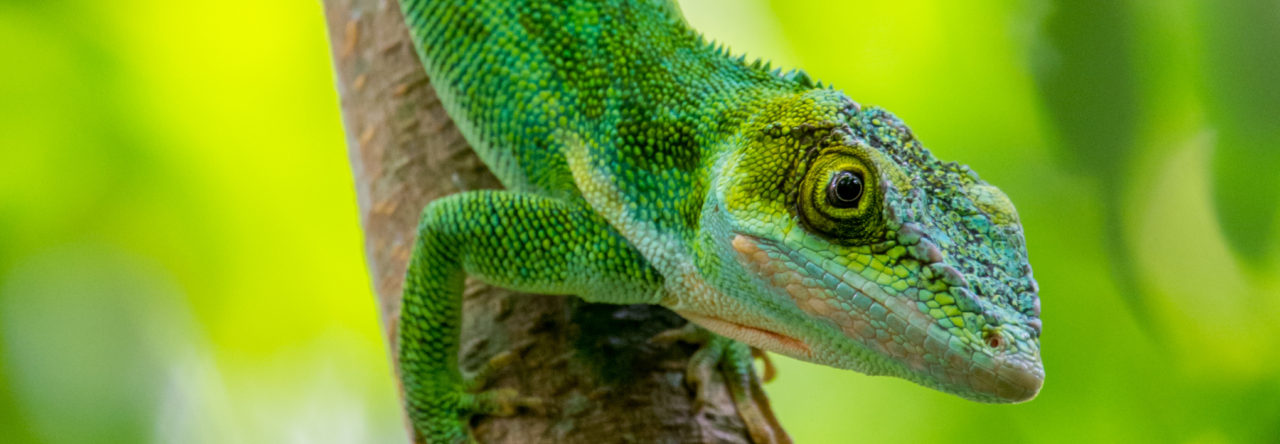Sarah Baade practically considers anole lizards her personal gardeners. The green little reptiles have a knack for keeping her company at her San Antonio home while she tends to her front yard tomatoes and backyard squash, poking out their slender heads from under her plants to stare at her.
She calls it a mutually beneficial relationship. The anoles eat any pesky bugs, and Baade rewards them with a free drink whenever she waters her gardens.
But there’s something else these simpatico green thumbs share: The joy of silence.
“It’s kind of my peaceful quiet time,” said Baade, who works as an audiologist. “They are my peaceful, quiet companions when I’m gardening.”
Anole lizards, the most common lizards in and around San Antonio, may not make much noise, but they sure make an impression — especially now as we see them more often while we spend more time in and around the house. And take it from another anole fan, one who’s studied them for nearly 20 years, there’s nothing common about this so-called common lizard.
“I think they’re incredibly charismatic,” said Michele Johnson, a biology professor at Trinity University who runs the kid-friendly website, lizardsandfriends.org. “I think that they’re a really interesting lizard because they seem so familiar, and yet there’s still things about them that we haven’t figured out yet.”
Here are some familiar and not so familiar facts about the anole.
Tomato, tomato. Anole, anole. San Antonio is home to the Carolina anole (Anolis carolinensis), sometimes just referred to as the green anole.
Anole is pronounced “ah-NOH-lee”, though Johnson noted most scientists say anole like “ah-NOLE.” She doesn’t think there’s one right way to say the name.
Anoles range beyond the Carolinas. The Carolina anole is native to North America and ranges across the southeastern United States, from around the middle of Texas east and up through the Carolinas. The lizard prefers warm and moist environments with trees, though you’re sure to spot them just about anywhere else there’s foliage, from forests and roadsides to lawns and doorsteps.
It’s easy being green. The Carolina anole also is known as the green anole for its bright, verdant color. The anole can change color into shades of brown, but that doesn’t make it a chameleon. Chameleons are not found in the Americas. Rather, anoles belong to the iguana family of reptiles.
Hey, baby, do you like my camo? Yes, an anole’s ability to change color can help it blend in with its surroundings, which is great for hunting insects and avoiding predators. But most anoles change color as a sign of dominance or sexual attraction, rather than trying to blend in.
“We know for sure it’s not camouflage,” Johnson said. “There’s been several studies.”
Little green men and women. Male and female anoles look almost exactly alike save for two distinguishing features. The female often sports a white dorsal stripe along her back, while the male displays a larger throat fan, or dewlap, that’s bright red and three times the size of the female’s fan.
Long tails, short bodies, short life spans. Anoles range in size from 5 to 8 inches long, and more than half of that is tail. Anoles live only around two to three years in the wild. The lizards are popular pets though, and can live up to seven years in captivity.
Days spent in the trees. Anoles are diurnal, meaning they’re active in the daytime. They’re also arboreal, meaning they live in trees.
They really toe the line. Johnson noted anoles have big toe pads that allow them to cling to surfaces.
They also cut and run. An anole will shed its tail to escape a predator. The twitching limb serves as a distraction for the lizard’s escape. A new tail will grow back, though not as long or as colorful as the original.
A bug’s life for breakfast, lunch and dinner. Anoles eat all sorts of insects, including moths, crickets, ants and spiders.
Keep off the dudes’ turf. Male anoles are extremely territorial and will fight other males to preserve their areas for themselves.
Self-reliant hatchlings. A few weeks after mating, a female anole will lay her first egg, then lay another every other week until she reaches around 10 eggs. The hatchlings then emerge 30 to 45 days later. The babies must fend for themselves without mother or father to care for them.
“I know that they had babies in my front garden because I’ve seen the babies,” Baade said. “It’s cool to see them scurry around.”
The anole is one of the X-Men. The Marvel comic book character Anole is one of the lesser-known mutants to join the heroic X-Men. The openly gay young hero exhibits lizardlike traits and abilities, including green scaly skin and the power to grow back lost limbs.
A first in genome sequencing. As part of scientists’ efforts to better understand the evolution of various animals, the green anole was the first reptile to have its entire genome sequenced. Johnson said the lizard was chosen because it has a small body and a fast reproduction time — and it’s way easier to keep in a lab than, say, a crocodile or snapping turtle.
She noted that sequencing the green anole has since led to a better understanding of such processes as forming eggs and regenerating tails. Take that, GEICO Gecko.
















